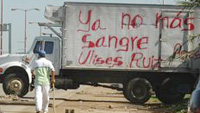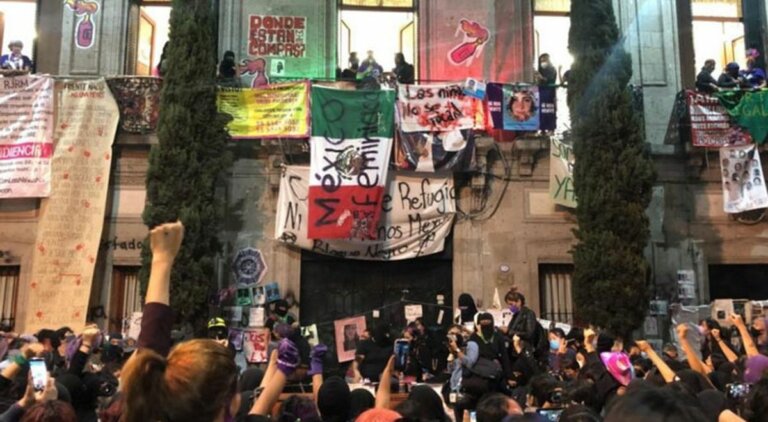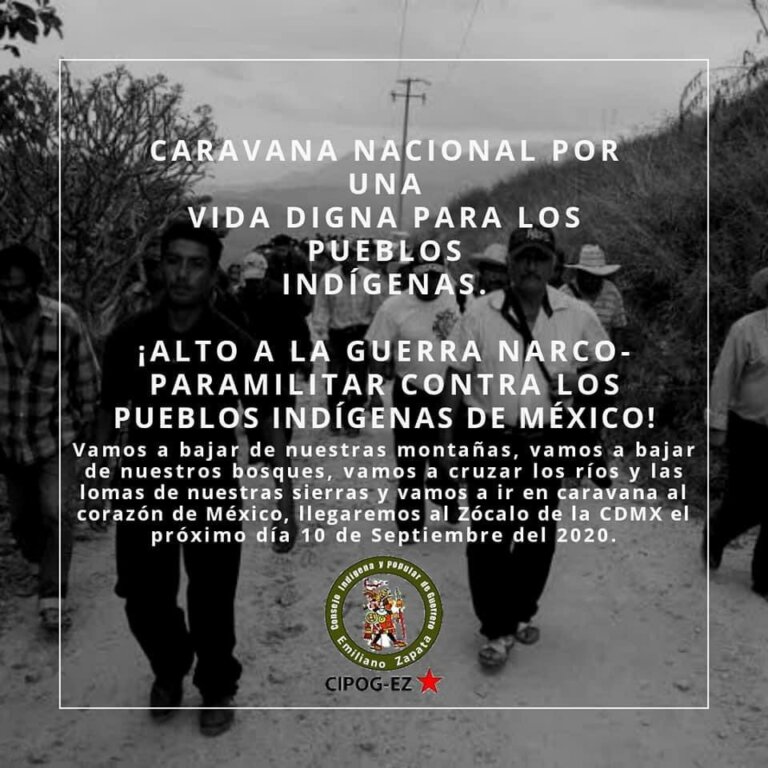Paramilitaries and police in Oaxaca have begun a violent campaign to shut down all media operations that are in opposition to PRI governor Ulises Ruiz Ortiz, and to silence the people’s movement, APPO, which has taken over governing the state. The television station that several hundred women had taken over on August 1st was invaded by police forces on August 21st and damaged beyond use. Radio station towers have also been attacked. Protesters have been shot in the streets by police or military forces who refuse to identify themselves. People in Oaxaca are calling for international solidarity: “Organize a protest at your local Mexican consulate or contact the… responsible individuals and let them know the whole world is watching.”
Global Indymedia: english | italiano | español | português | deutsch
The Popular Assembly of the People of Oaxaca (APPO, by its Spanish initials) declared itself the governing body of Oaxaca on the morning of July 5th. Its immediate decisions included: a return to classes for two weeks on Monday July 10th, so that the schoolchildren would not lose their school year; putting the encampment in the zocalo into the hands of the alternative government; strengthening the fight to oust Ulises Ruiz Ortiz (URO) as governor; and boycotting the tourist Guelaguetza celebration in favor of a free celebration for the people. (NarcoNews report) However, divisions emerged between the teachers’ union and the social organizations in the APPO.
On July 22nd, Radio Universidad was attacked while the majority of people in Oaxaca were at the “People’s Gualaguetza” in the Zocalo. The radio station is used as a collection area for food and supplies, for the protesting teachers for the Gualaguetza people who had come in from the countryside. At that time, there were mostly older women and children in the building. They resisted the attack and called for supporters to come defend the station. The announcers continued to call for the removal of Governor Ruiz and the entire state government, for his attempts to kill the protesters. (NarcoNews report)
On August 1st, a large group of Oaxacan women marched through the city center and took over the state TV station (Channel 9) for APPO. They began broadcasting radio and television within hours, and demanded that URO resign. (Narco News report) The next morning they broadcast footage from the June 14th police attack that no TV station had ever dared to show. Read more
The transmitter for Radio Planton, the voice for the (teachers’) movement in the center of Oaxaca city, had been destroyed during the unsuccessful eviction attempt on June 14. The transmitter for Radio Universidad, another media of the movement and under control of the students, was ruined by infiltrators in the beginning of August. Report
On August 7th, Indian Organizations for Human Rights in Oaxaca (part of APPO) called for a Red Alert. They were seeking help to reinforce the blockades of local, state, and federal government buildings, and Channel 9, amidst the threat of intense police activity in the state’s capitol. That week the complicity between right-wing extremists of the national and state governments was confirmed by President Fox’s immediate grant of a request, petitioned by (ex)governor Ulises Ruiz Ortiz, to send in the Federal Prevention Police (PFP) – a nefarious militarized police.
Drive-by shootings at Radio Universidad and Channel 9 escalated, and on August 10th, several marchers were hit by shots fired from a house along the route. One supporter of the teachers was killed, and two others were wounded. APPO captured several suspects and turned them over to federal law enforcement(?). Weekly News Update report | Narco News report from August 10th
During the week of August 14th, approximately 4 APPO members were fatally shot, and tear gas and truncheons were used by police to injure and try to break up the demonstrators. Arrest warrants were issued for over 50 grassroots activists. Democracy Now report and interviews from August 18th A news summary by esperanza reports that the uprising in Oaxaca is now connecting with the protests against election fraud in all of Mexico. Narco News reports that since a national forum to discuss ungovernability and a new constitution was scheduled for Wednesday and Thursday in Oaxaca, a total work stoppage was scheduled for Friday, August 18th, to allow guests to leave before the roads and highways were blocked. More than 200 civil organizations and academics from different parts of the nation were invited to participate. Some 80,000 people participated in the work stoppage. Report and Analysis from Narco News reporter Nancy Davies.
Early Monday morning on August 21st, the encampment at the Channel 9 antenna was attacked and the damage made it unusable. Moments later, APPO sympathizers took over installations of the majority of the city’s radio commercial frequencies, where they urged the population of Oaxaca to take to the streets to defend encampments located throughout the city. People protesting outside one of the commercial radio stations were subjected to a drive-by at 9am by unidentified individuals. The popular movement continues to demand the resignation of URO.
Report from Indy reporter JLaw | George Salzman’s NarcoNews report | George Salzman’s Photos | BBC report
Another teacher is dead after armed police traveled about Oaxaca city on Tuesday night August 22nd, shooting at protesters at will. As the people of Oaxaca were alerted via radio to the aggressions occurring in the city, hundreds of people filled the streets to offer back-up and to try to detain the aggressors. The 500 barricades that protect the teachers’ encampments around the city were reinforced. People in Oaxaca are calling for international solidarity: “Organize a protest at your local Mexican consulate or contact the… responsible individuals and let them know the whole world is watching.”
Jlaw’s August 23rd report and photos with links to video
A post on Austin Indymedia reports that “unknown persons have published on the website http://oaxacaenpaz.org.mx/ pictures and home addresses of a number of social leaders exhorting readers to ‘look for them and detain them.’ The website also has a running tally of social movement leaders already detained, stating ‘they’ve already fallen.’ Also, the recently killed protestor, by presumably government agents, José Jiménez Colmenares, has a grotesque red X across his face.”
Indybay’s June 2006 coverage of Oaxaca | IndyOaxaca | Chiapas Indymedia | Pueblo de Oaxaca Blog with Photos | Narco News Oaxaca Coverage | More links on ElEnemigoComun.net | Film: “Granito de Arena”




Oaxaca, Mexico: Free Speech in the “Dirty War”
http://upsidedownworld.org/archives/mexico/oaxaca-mexico-free-speech-in-the-qdirty-warq/
Written by Kelly Komenda and Sara Yassky
Tuesday, 22 August 2006
Since May 22, Oaxacan teachers have been occupying the main plaza in the city of Oaxaca.
In the beginning of the occupation, the teachers’ demands from the government were simple: fair wages to adjust for their cost of living and the guarantee of a better educational environment for their students, which to the teachers meant funding for books, supplies, uniforms and food.
The state government of Ulises Ruiz Ortiz refused to negotiate with the teachers, so the teachers therefore refused to leave the plaza. But around 4 a.m. on June 14, Ruiz Ortiz sent approximately 1,000 state police officers to attack the sleeping teachers.
The police tactics included beating, torturing, raping, disappearing, and even killing some of the fleeing protestors. The teachers’ movement responded by transforming itself into a state-wide people’s resistance against government repression, while people throughout the country have expressed their solidarity with the Oaxacan people.
“We’ve learned and we’re defending ourselves. We realized that…we need to raise our voices.”
On Aug. 1, over 3,000 women fortified their voices with the ringing of their pots and pans as they marched the city streets of Oaxaca, demanding to be heard.
“We decided to march to show as women, we have power too, and we can do something with it,” one marcher explained. “We decided to do what’s been done in Chile and Argentina and to take the streets with our pots and pans.”
After first stopping at a downtown hotel where Governor Ruiz Ortiz had supposedly been holding undercover meetings due to the people’s insistence on his exit, the women spontaneously decided to march to the state-run television and radio station to demand an hour of airtime in order to “tell the truth” about the circumstances of the state repression. Not surprisingly, the station employees embodied the silencing forces that the women were marching against, and the women’s demands were denied. From outside the station’s security gates, husbands, brothers, sons, and compañeros tried to “reason” with the angry and fed-up women, asking them to “regroup” and “calmly” think through their next course of action. But the women had already decided that they had come to the station to be heard, so with their pots and pans as their weapons, they successfully took over Channel 9 and what is now known as “Radio Cacerola” ( cacerola meaning pan).
For the next 20 days, Channel 9 and Radio Cacerola served as critical mediums of communication for the people’s movement in Oaxaca. As promised, the women used the media outlets to tell the truth. Radio Cacerola was an important tool for discussion and a vital source of information regarding problems, mobilizations, warnings, and the latest news in an unpredictable city. Channel 9 was used to broadcast images of the June 14 raid on the plaza, including documentaries of “social movements and the repression that the people have suffered on behalf of different governments throughout the years,” as well as other informative programming pertaining to health, farm workers movements, water issues, and genetic engineering (Noticias, Aug. 20). An hour each day was dedicated to airing citizen complaints. The women were also offering workshops, lead by Oaxacan youth, to help both the women and the people in the community learn the technical skills necessary to run the station.
The Aug. 20 edition of Noticias, an Oaxacan daily newspaper, reported that because the start of school has been delayed indefinitely due to the teachers’ strike, “teachers were analyzing the possibility of developing an alternative education project” using Channel 9. The takeover of the government TV and radio station had not only developed immediate functional uses for the community, but also served as a powerful model of empowerment and reclamation asserted by the women.
The women-run stations, with women behind the microphones and in front of the cameras, signify a resistance to the traditional roles that these women have been expected to fulfill. One woman, who was a part of the takeover, explained that they are “creating a supportive space in which women can realize their capabilities.”
In an atmosphere where the government had already attacked two radio stations that were principal forms of communication for the anti-repression movement (Radio Plantón on June 14 and the university radio on July 22), the women refused to be silenced and presented themselves as a force to be reckoned with, as they reclaimed the freedom of speech which the government views as a threat. As one woman stated, “Our biggest crime is to talk, to take to the streets.”
In the pre-dawn hours of Aug. 21t, the women of Channel 9 and Radio Cacerola were reminded of the seriousness of their threat. Between the hours of 3 a.m. and 4 a.m, buses and cars were set on fire in encampments throughout the city, in what the women explain was “a distraction.” The people at the Channel 9 and Radio Cacerola encampment awoke to ringing church bells—a system that the protestors use to alert people that there are problems in the area and to call people together.
As folks gathered at the encampment, they learned that a group of armed persons had been sent to “dislocate” the guards protecting the broadcasting antenna for Channel 9 and Radio Cacerola. According to a communiqué released that morning by the Popular Assembly of the People of Oaxaca (APPO), “They entered shooting directly at the people who were guarding the facilities, causing them to retreat and thus burning the broadcasting equipment.”
At least one teacher, Sergio Vale Jiménez, was injured with a gunshot wound to the leg. And at least three other people who were guarding the antenna are missing, adding to the list of the disappeared in what is being called “the dirty war.”
Responding to the latest act of violence by the government, one woman who was a part of the Channel 9 and Radio Cacerola takeover explained, “They want to cut off our freedom of expression so that we are left mute.”
As the news spread at the Channel 9 and Radio Cacerola encampment, the people organized themselves with decisiveness and with the model of the women’s takeover as their inspiration. They marched to the neighborhood of El Rosario where residents were being awoken by church bells; women were in the streets banging their pots and pans, and car horns were sounding. El Rosario is home to a broadcasting antenna which covers nearly the entire state of Oaxaca through nine different transmission signals. The people of El Rosario rose from their slumber to join the marchers from the encampment to take over the antenna. By sunrise, one could tune into several newly taken, peoples’ radio stations. A new encampment was quickly formed to protect the antenna of El Rosario because, as one woman said, “We can’t be left without methods of communication.”
Each side of this intense conflict in Oaxaca is aware of the power of the word. The government has resorted to violence to silence the people, and the people are responding with non-violence and their most powerful weapon: their voices.
“We know that our lives are in danger and the lives of our families, but we stay?we are an example of a people that are fighting, we aren’t selling out?we won’t sell our dignity.”
Even though the women of Channel 9 and Radio Cacerola are aware that they cannot fix the damaged antenna, they remain undeterred: “We are not going to loose time fixing something that we’re not capable of. We are re-planning and we are going to take over more spaces.”
No one in Oaxaca knows what the outcome of this conflict will be, but the women have a vision for the taken stations: “We will keep them.”
Kelly Komenda and Sara Yassky are activists from the United States who have been self-educating about organizing within people’s liberation movements in Latin America. They are currently in Oaxaca City, Oaxaca, Mexico.